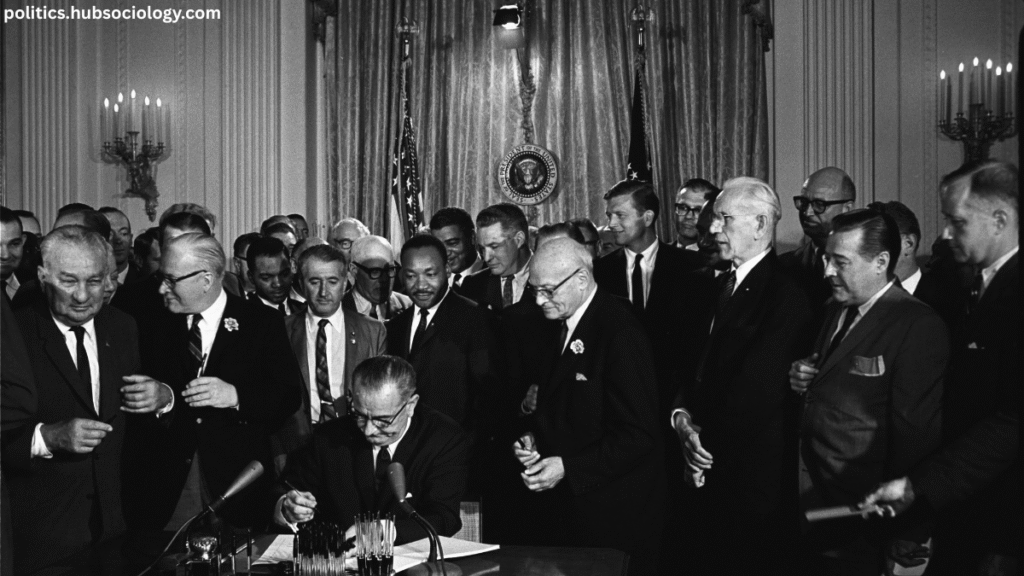Introduction on Marxian Perspectives of Civil Society
Civil society is a central concept in political science, referring to the realm of voluntary associations, social movements, and institutions that exist between the state, the market, and the private sphere. Within Marxist theory, civil society is not seen as an autonomous or neutral space but rather as a terrain of ideological and class struggle. While Karl Marx viewed civil society primarily as an extension of bourgeois economic dominance, Antonio Gramsci expanded this understanding by introducing the concept of cultural and ideological hegemony. This article examines the Marxian perspectives of civil society, focusing on the contributions of Marx and Gramsci, and analyzes their implications for political science.

Table of Contents
Karl Marx’s Conception of Civil Society
1. Civil Society as the Sphere of Bourgeois Domination
For Karl Marx, civil society (bürgerliche Gesellschaft) was intrinsically linked to the capitalist mode of production. In The German Ideology (1846), Marx and Engels argued that civil society emerges alongside the modern state and is fundamentally shaped by class relations. Unlike Hegel, who saw civil society as a mediating sphere between the family and the state, Marx viewed it as the domain where bourgeois economic interests dominate.
Marx argued that civil society under capitalism is structured by private property, market exchanges, and class antagonisms. The institutions of civil society—such as trade unions, religious groups, and media—function to reproduce capitalist ideology, ensuring the continued dominance of the bourgeoisie. Thus, Marx’s critique suggests that civil society is not a neutral space but one that reinforces economic exploitation.
2. The State as a Tool of the Class in Power
Marx made the well-known claim that “the executive of the contemporary state is simply a committee for handling the common affairs of the whole bourgeoisie” in The Communist Manifesto (1848). The government, in this view, does not stand above class interests but serves to protect capitalist property relations. Civil society, therefore, operates within the constraints of state power, which is wielded by the dominant economic class.
Marx’s analysis implies that genuine emancipation requires the abolition of bourgeois civil society through proletarian revolution. Only by dismantling capitalist property relations can a classless society emerge, where civil society is no longer a site of exploitation.
3. Limitations of Marx’s View
While Marx’s critique of civil society highlights its economic foundations, it has been criticized for being overly deterministic. His focus on class struggle as the primary driver of history tends to downplay the role of culture, ideology, and non-economic institutions in shaping political consciousness. This limitation was later addressed by Antonio Gramsci, who provided a more nuanced understanding of civil society.
Antonio Gramsci’s Theory of Hegemony and Civil Society
1. Civil Society as the Site of Ideological Struggle
By adding the idea of hegemony—the process by which the ruling class upholds power not only via coercion but also by cultural and ideological consent—the Italian Marxist theorist Gramsci broadened Marx’s framework. In Prison Notebooks (written between 1929-1935), Gramsci distinguished between political society (the state, police, military) and civil society (churches, schools, media, trade unions).
Unlike Marx, Gramsci saw civil society as a crucial battleground where hegemony is either reinforced or contested. The bourgeoisie maintains its dominance not only through economic control but also by shaping popular beliefs, values, and norms. Institutions like education, media, and religion play a key role in legitimizing capitalist rule.

2. The Role of Intellectuals
Gramsci emphasized the role of organic intellectuals—thinkers and activists who emerge from within a social class to articulate its interests. Unlike traditional intellectuals (e.g., academics, clergy), organic intellectuals actively engage in ideological struggles within civil society. For the working class to achieve hegemony, it must develop its own counter-hegemonic intellectuals who can challenge bourgeois ideology.
3. War of Position vs. War of Maneuver
Gramsci introduced two strategies for revolutionary change:
- War of Maneuver: A direct, insurrectionary assault on state power (e.g., the Bolshevik Revolution).
- War of Position: A long-term cultural and ideological struggle within civil society to win popular consent before seizing state power.
Gramsci argued that in advanced capitalist societies, where civil society is well-developed, a war of position is necessary. Revolutionary movements must first establish counter-hegemonic institutions (e.g., alternative media, radical education) to weaken bourgeois dominance before a political revolution can succeed.
4. Gramsci’s Influence on Political Science
Gramsci’s ideas have profoundly influenced critical theory, cultural studies, and post-Marxist thought. His analysis of civil society as a contested ideological space has been used to study media discourse, education systems, and social movements. Scholars like Stuart Hall and Chantal Mouffe have applied Gramscian concepts to analyze neoliberalism, identity politics, and populism.
Comparative Analysis: Marx vs. Gramsci on Civil Society
| Aspect | Karl Marx | Antonio Gramsci |
|---|---|---|
| Definition of Civil Society | Economic sphere of bourgeois dominance | Cultural-ideological sphere of hegemony |
| Role of the State | Instrument of class rule | Partly autonomous, interacts with civil society |
| Revolutionary Strategy | Proletarian revolution (violent overthrow) | War of position (ideological struggle) |
| Intellectuals | Less emphasis | Central to hegemony and counter-hegemony |
| Civil Society’s Autonomy | Subordinate to economic base | Semi-autonomous, can challenge hegemony |
Implications for Contemporary Political Science
1. Civil Society and Neoliberalism
Gramsci’s framework helps explain how neoliberal ideology has been naturalized through civil society institutions (e.g., corporate media promoting free-market values). Marxist-Gramscian analysis reveals how privatization and deregulation are justified as “common sense,” limiting alternative economic visions.
2. Social Movements and Counter-Hegemony
Movements like Black Lives Matter, environmental activism, and labor unions can be understood as counter-hegemonic struggles within civil society. Gramsci’s theory provides tools for analyzing how marginalized groups challenge dominant narratives.
3. Authoritarianism and Civil Society
In authoritarian regimes, civil society is often suppressed because it poses a threat to state hegemony. Gramsci’s insights help explain why dictatorships censor media, control education, and persecute intellectuals—to prevent counter-hegemonic resistance.
Conclusion on Marxian Perspectives of Civil Society
Karl Marx and Antonio Gramsci offer distinct but complementary perspectives on civil society. While Marx emphasized its economic foundations and class character, Gramsci expanded the analysis to include cultural and ideological dimensions. Gramsci’s theory of hegemony remains particularly relevant for understanding how power operates in modern democracies, where consent is as crucial as coercion.

For political science, the Marxian-Gramscian approach provides a critical lens to examine civil society not as a neutral space but as a contested terrain where ideological battles shape political outcomes. By integrating economic and cultural analysis, this framework remains indispensable for studying power, resistance, and social change.
Highly Recommended Books on Marxian Perspectives of Civil Society
- MODERN POLITICAL THEORY By SP Varma – Amazon Link – https://amzn.to/43wMFWQ
- Political Theory: An Introduction by Andrew Heywood- Amazon Link – https://amzn.to/4j6lffe
Topic Related Questions on Marxian Perspectives of Civil Society
5-Mark Questions on Marxian Perspectives of Civil Society (Short Answers)
- Define civil society from Karl Marx’s perspective.
- What is the role of the state in civil society according to Marx?
- How does Gramsci’s concept of hegemony differ from Marx’s view of ideology?
- Name two institutions Gramsci associates with civil society.
- What is the difference between “political society” and “civil society” in Gramsci’s theory?
- How does Marx view the relationship between civil society and the economy?
- What is the role of intellectuals in Gramsci’s theory of civil society?
- Explain Gramsci’s concept of the “war of position.”
- Why does Marx consider civil society a site of class struggle?
- How does Gramsci’s theory explain the persistence of capitalism in democratic societies?
10-Mark Questions on Marxian Perspectives of Civil Society (Brief Essays)
- Compare Marx’s and Gramsci’s views on civil society.
- Explain Gramsci’s concept of hegemony and its relevance to civil society.
- Discuss how Marx’s critique of civil society is rooted in his theory of class struggle.
- Analyze Gramsci’s distinction between “war of position” and “war of maneuver.”
- How does Gramsci’s theory of civil society help explain cultural domination under capitalism?
- Evaluate Marx’s argument that civil society is an extension of bourgeois economic power.
- Discuss the role of organic intellectuals in Gramsci’s theory of counter-hegemony.
- Why does Gramsci emphasize ideological struggle in civil society rather than just economic revolution?
- How does Marx’s view of civil society differ from liberal perspectives?
- Assess the relevance of Gramsci’s theory of civil society in analyzing modern media and education.
15-Mark Questions on Marxian Perspectives of Civil Society (Long Essays)
- Critically examine Karl Marx’s and Antonio Gramsci’s perspectives on civil society. How do they differ, and where do they converge?
- “Civil society is not a neutral space but a battleground of hegemony.” Discuss this statement in light of Gramsci’s theory.
- Analyze how Marx’s materialist approach to civil society contrasts with Gramsci’s cultural-ideational approach.
- How does Gramsci’s theory of civil society provide a framework for understanding resistance movements in contemporary politics?
- “The state is merely an instrument of the ruling class.” Evaluate this Marxist claim in the context of civil society.
- Discuss the relevance of Gramsci’s concept of hegemony in analyzing neoliberalism and global capitalism.
- Compare Marx’s revolutionary strategy with Gramsci’s “war of position.” Which is more applicable in today’s political context?
- How does Gramsci’s theory of civil society challenge traditional Marxist economic determinism?
- Examine the role of civil society in sustaining or challenging capitalist ideology, using Marxian and Gramscian perspectives.
- “Gramsci’s theory of civil society offers a more nuanced understanding of power than Marx’s economic reductionism.” Discuss.

1 thought on “Marxian Perspectives of Civil Society”